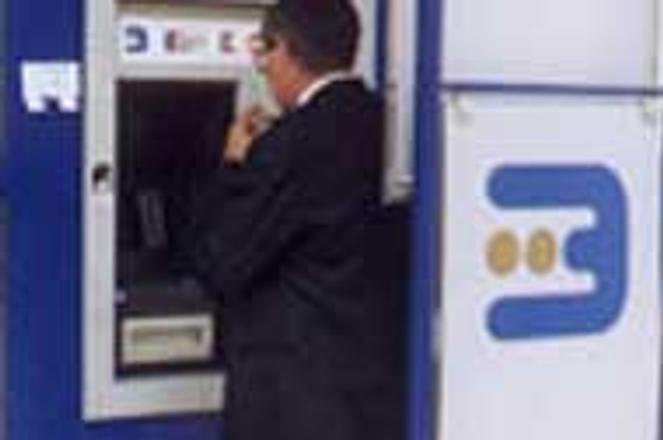Slovaks use ATM's more often than other nationalities, VISA says.photo: Ján Svrček
While banknotes have become a relic of the past for many western consumers, plastic still invokes curious glances from domestic shopkeepers in Slovakia. With wide-spread proliferation of debit and credit cards matching the West still seemingly years away, "put it on my credit card" is not an expression one here can expect to hear anytime soon.
According to local stores, banks and credit card companies, however, the trend is shifting as customers have begun to request the non-traditional forms of payment in dramatically increasing numbers, especially debit cards. But while debit card usage increased last year as much as four-fold, the credit card boom that struck America and western Europe over a decade ago still has a long way to go.
"The total annual Slovak cardholder expenditure reached $379 million in 1998," a recent Visa International press release said. "That is an increase of almost 400% over the previous year, one of the highest increases among the 37 countries in Central Europe, Middle East and Africa served by Visa."
Ivan Remšík, director of Visa International for central and eastern Europe, said that the consumer and banking sectors were both making the switch-over because of convenience and a wider range of selection. "The situation is changing," he said. "Today, we see banks creating effective infra-structures [encouraging payment cards] which offer more possibilities."
Supporting his claims, Remšík pointed to the statistics. Over 365,000 Visa cards now exist in Slovakia, an increase of 75% from 1997. The average Slovak cardholder uses their card 33 times per year with an average transaction of 1,450 Slovak crowns. In response, more stores tried to accommodate cardholders which has resulted in an ATM outlets rise of 77% and a Visa outlets rise of 50%.
A representative of Dunaj department store said that they had noticed a lofty increase of payment by cards, mainly debit. "During the last two years, the numbers of such payments have increased significantly," he said. "Now, 8 to 10% of all payment here is made by debit, which is approximately 15 million Slovak crowns per year."
Other local stores also reported a stronger customer tendency to use debit cards. Ikea in Bratislava said that "in 1997, debit card payments constituted 3% of our annual turnover. Now, it counts for 12%, or six to seven million Slovak crowns per month." Likewise, Baumax reported that "15 to 20% of all payments on a daily basis are made with debit cards."
The sudden debit popularity has left some wondering why credit card use hasn't quickly followed the footsteps of the their debit counterparts. According to Jaroslav Masrna from Ľudová Banka's department of payment cards, the answer is strictly and simply economic.
Masrna explained that since the debit card doesn't operate on credit, anyone with a bank account can acquire a debit card, which takes money directly out of the customer's bank account when the card is used. "Around 80% of all our clients have a payment card," he said.
However, of those 80%, "there is only one credit card for every 20 debit cards" amongst Ľudová Banka clients. The failure of credit cards to secure a prominent location in the wallet of the Slovak consumer, Masrna explained, was because of the fact that the average Slovak didn't have the necessary money to even begin a credit card account.
"At our bank, if you want a credit card you need to have 120,000 crowns [or ATS40,000] in your account," he said. "This is a rather big guarantee to make and that is why people don't use it yet."
But according to one analyst, another factor helping supress the spread of credit cards is a belief on the part of the banks that Slovak consumers are not to be trusted. "Credit cards are not used in Slovakia because banks do not believe their clients, so the guarantees needed are high," said Miloš Božek from J&T Securities.
"The problem is that consumer's credits are still not the main priority," Visa's Remšík said in agreement. "The banks still have various reasons for behaving conservative, the main one being that they obviously doubt whether the money will return. And I must say that these doubts are partly justified."
Remšík added that until legal regulations assuring the repayment of credits like those that exist in western countries were implemented, the credit card industry would never take off in Slovakia. "It is necessary that the banks must create a defence against everybody not paying their accounts," he said.
For now, the majority of plastic transactions will remain tied to the sidewalk Automatic Teller Machine. According to VISA, Slovakia now has more ATMs per capita than any other country in central and eastern Europe. Slovaks also use these machines more than their neighbors, suggesting that they tend to withdraw their money in small amounts, but frequently, and immediately spend the cash. Over 98% of Slovakia's VISA transactions are cash withdrawals, Remšík said
.Olivia Strapeková contributed to this story


